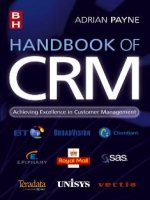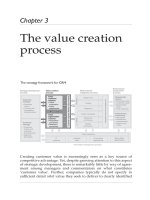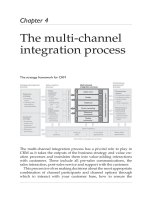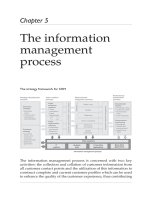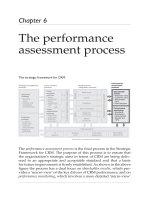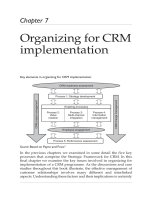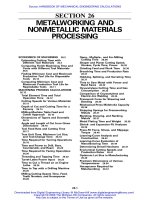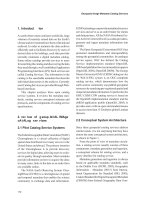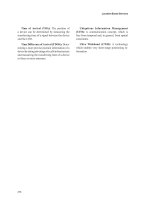HANDBOOK OF CRM: Achieving Excellence in Customer Management Part 1 potx
Bạn đang xem bản rút gọn của tài liệu. Xem và tải ngay bản đầy đủ của tài liệu tại đây (894.37 KB, 59 trang )
HANDBOOK OF CRM:
Achieving Excellence in Customer
Management
HCRM-FM.qxd 9/16/05 10:45 Page i
TLFeBOOK
To
Penelope and Christopher
HCRM-FM.qxd 9/16/05 10:45 Page ii
HANDBOOK OF
CRM:
Achieving Excellence in Customer
Management
Adrian Payne
• BOSTONAMSTERDAM •HEIDELBERG •LONDON • NEW YORK •OXFORD
PARIS • SAN DIEGO •SAN FRANCISCO • S INGAPORE •SYDNEY •TOKYO
Butterworth-Heinemann is an imprint of Elsevier
HCRM-FM.qxd 9/16/05 10:45 Page iii
Butterworth-Heinemann is an imprint of Elsevier
Linacre House, Jordan Hill, Oxford OX2 8DP
30 Corporate Drive, Suite 400 Burlington, MA 01803
First published 2005
Copyright © 2005, Adrian Payne. All rights reserved.
The right of Adrian Payne to be identified as the author of this work has been
asserted in accordance with the Copyright, Designs and Patents Act 1988.
No part of this publication may be reproduced in any material form (including
photocopying or storing in any medium by electronic means and whether
or not transiently or incidentally to some other use of this publication) without
the written permission of the copyright holder except in accordance with the
provisions of the Copyright, Designs and Patents Act 1988 or under the terms of
a licence issued by the Copyright Licensing Agency Ltd, 90 Tottenham Court Road,
London, England W1T 4LP. Applications for the copyright holder’s written
permission to reproduce any part of this publication should be addressed
to the publisher.
Permissions may be sought directly from Elsevier’s Science and Technology Rights
Department in Oxford, UK: phone: (ϩ44) (0) 1865 843830; fax: (ϩ44) (0) 1865 853333;
e-mail: You may also complete your request on-line via
the Elsevier homepage (), by selecting ‘Customer Support’
and then ‘Obtaining Permissions’.
British Library Cataloguing in Publication Data
A catalogue record for this book is available from the British Library
Library of Congress Control Number: 2005922524
A catalogue record for this book is available from the Library of Congress
ISBN-13: 978-07506-6437-0
ISBN-10: 07506-6437-1
Typeset by Newgen Imaging Systems (P) Ltd, Chennai, India
Printed and bound in Great Britain
For information on all Butterworth-Heinemann publications
visit our website at
Working together to grow
libraries in developing countries
www.elsevier.com | www.bookaid.org | www.sabre.org
HCRM-FM.qxd 9/16/05 10:45 Page iv
Contents
Preface xiii
About the Author xvii
Acknowledgements xix
Introduction 1
1 A strategic framework for CRM 4
The origins of CRM 6
The key principles of relationship marketing 9
An emphasis on retention of profitable customers 9
An emphasis on multiple markets 9
An emphasis on a cross-functional
approach to marketing 10
The rise of CRM 11
Marketing on the basis of relationships 11
Viewing customers as business assets 12
Organizing in terms of processes 12
From reactive to proactive use of information 13
Deploying IT to maximize the value of information 14
Balancing the value trade-off 15
Developing ‘one-to-one’ marketing 16
The role of CRM 17
Varying definitions of CRM 18
The CRM continuum – three perspectives of CRM 18
Use of CRM and its terminology 20
A definition of CRM 22
Types of CRM 23
The size and nature of the CRM market 24
Sector growth within the CRM market 25
CRM and software vendors 25
Five key cross-functional CRM processes 29
The need for a CRM strategic framework 30
Process 1: the strategy development process 32
Process 2: the value creation process 32
HCRM-FM.qxd 9/16/05 10:45 Page v
Process 3: the multi-channel integration process 32
Process 4: the information management process 32
Process 5: the performance assessment process 33
The structure of the book 33
Chapter 1: Developing a strategic framework for CRM 33
Chapter 2: The strategy development process 34
Chapter 3: The value creation process 34
Chapter 4: The multi-channel integration process 35
Chapter 5: The information management process 35
Chapter 6: The performance assessment process 36
Chapter 7: Organizing for CRM implementation 37
Checklist for CRM leaders 38
2 The strategy development process 39
Business strategy 41
The role of business strategy 42
Business vision 43
Industry and competitive characteristics 47
The new competitive landscape 47
Putting the new economy in context 48
Changes in industry structure and evolution 50
Analysing the industry and competitive environment 51
Focusing on business strategy 60
Customer strategy 61
The role of customer strategy 61
Customer choice and characteristics: the role of
market segmentation 62
Who is the customer? 63
Market segmentation 64
Definition of the relevant market 65
Criteria for market segment viability 65
Considering the alternative bases for segmentation 66
Segment granularity: from mass marketing to
‘one-to-one’ marketing 69
‘One-to-one’ markets and permission marketing 69
Mass customization 71
Communities or segments? 73
Focusing on customer strategy 75
Aligning business strategy and customer strategy 78
CRM strategy development 78
Product-based selling 81
Managed service and support 82
vi Contents
HCRM-FM.qxd 9/16/05 10:45 Page vi
Customer-based marketing 83
Individualized CRM 84
Migration paths for CRM 87
Summary 88
Checklist for CRM leaders 90
Case 2.1 DnB Nor Bank pursues an enterprising
strategy with Teradata 92
Case 2.2 RS components: towards individualized
CRM with BroadVision 97
3 The value creation process 102
The value the customer receives 103
The nature of value – what the customer buys 104
How the core and augmented offer add value 104
How relationships add value 111
How brands add value 117
The value proposition 123
Formulating the value proposition 124
The value delivery system 128
Building the value proposition 129
Value assessment 130
Traditional means of customers’
assessment of value 131
Improving value assessment using trade-off
analysis 132
The value the organization receives 135
Customer profitability 136
Why customers differ in their real profitability 137
Understanding future profit potential 139
Customer acquisition and its economics 140
Customer acquisition at United Electricity plc 140
Acquisition within different channels 142
Improving acquisition activities 142
Customer retention and its economics 143
Customer retention at United Electricity plc 144
Why retention improvement impacts profitability 145
Acquisition and retention activities in practice 146
A framework for customer retention improvement 148
Step 1: measurement of customer retention 148
Step 2: identification of causes of defection
and key service issues 148
Step 3: corrective action to improve retention 149
Contents vii
HCRM-FM.qxd 9/16/05 10:45 Page vii
Customer segment lifetime value 149
Defining the role of customer lifetime value 150
Calculating customer lifetime value 152
Building profit improvement 153
Summary 155
Checklist for CRM leaders 157
Case 3.1 BT – creating new customer value propositions 159
Case 3.2 Building new value propositions at Zurich Financial
Services 164
4 The multi-channel integration process 168
Channel participants and channel options 169
The development of electronic channels 170
Reviewing industry channel structures 171
Channel participants 171
Reviewing channel alternatives 172
Understanding structural change – the role of
intermediaries 173
Disintermediation 173
Reintermediation 174
Benchmarking structural change 175
Orientation of intermediaries 176
Developing market structure maps 177
Channel options and categories 179
Channel categories 179
Mobile commerce as a separate channel category 180
Integration and the channel categories 184
Sales force 185
Outlets 185
Telephony 186
Direct mail 187
E-commerce 187
M-commerce 188
Combining channels 189
Channel strategies 190
Channel strategy options 191
The role of a multi-channel strategy 192
Understanding the customer relationship life-cycle 193
Understanding the customer experience 195
The customer experience and emotional goodwill 196
Evaluating the customer experience 196
viii Contents
HCRM-FM.qxd 9/16/05 10:45 Page viii
The customer experience within channel 198
The customer experience across channels 198
Improving the customer experience – the role of technology 199
The ‘perfect’ customer experience 200
Building a multi-channel strategy 205
Develop strategic multi-channel objectives 205
Understand needs and concerns of key customer segments 206
Undertake a strategic review of industry structure and
channel options 208
Understand shifts in channel usage patterns 209
Review channel economics 210
Economics of the online retail toy market 211
Economics of the online grocery market 211
Develop an integrated channel management strategy 212
Planning channel strategy across stakeholders 214
Summary 215
Checklist for CRM leaders 216
Case 4.1 Ideal Boilers: a mobile solution for plumbers 218
Case 4.2 Guinness – Delivering the ‘Perfect Pint’ 222
5 The information management process 226
The role of information, IT and information management 228
Information 228
IT 228
Information management 229
The information management process 230
The technical barriers in CRM 232
The data repository 233
Selecting and combining technology options for CRM 236
Tactical database and decision support systems 237
Data marts 239
Enterprise data warehouse 241
Integrated CRM solutions 243
The choice of technology options 245
Analytical tools 247
Standard data mining 248
Visualization tools 248
Segmentation, prediction, deviation
detection and link analysis 248
Neural networks 250
Decision trees 250
Contents ix
HCRM-FM.qxd 9/16/05 10:45 Page ix
Task-specific analysis tools 251
Market segmentation analysis 251
Affinity grouping 252
Churn management 252
Customer profiling 253
Profitability analysis 253
Online analytical processing (OLAP) 254
IT systems 255
Selecting hardware 256
Front-office and back-office applications 258
Front-office applications 259
Sales force automation 260
Call-centre and help-desk management 260
Product configuration 262
Marketing automation and campaign management 263
Back-office applications 264
Opportunities offered by emerging technology 265
Business process outsourcing, business service
provisioning and application service provisioning 266
Business process outsourcing (BPO) 267
Application service provider (ASP) 267
Business service provider (BSP) 267
Selecting a CRM solution 268
Data protection, privacy and codes of practice 270
Timing of technology introduction 271
Summary 272
Checklist for CRM leaders 273
Case 5.1 Barclays introduces the ‘intelligent sell’
with SAS
®
technology 275
Case 5.2 Halifax gives extra value with E.piphany
real-time solutions 279
6 The performance assessment process 283
The need for a systematic approach 284
Understanding the key drivers of shareholder results 286
Shareholder value, customer value, employee
value and cost reduction 287
Employee value 288
Customer value 289
Shareholder value 291
Cost reduction 293
x Contents
HCRM-FM.qxd 9/16/05 10:45 Page x
Linking shareholder value, employee value,
customer value and cost reduction 294
Developing appropriate standards, metrics and KPIs 295
Standards 296
The QCi Customer Management Assessment
Tool (CMAT) 297
Customer Operations Performance Centre (COPC)
Standard 298
Metrics 300
Customer metrics 300
People and process metrics 301
Strategic metrics 302
Output and comparative metrics 302
Special metrics 303
Key performance indicators 303
Multiple measures and linkage models 304
The balanced scorecard 305
Linkage models and the service-profit chain 306
Establishing a CRM performance monitoring system 309
Developing strategy maps and success maps 309
Development of metrics and KPIs for your business 311
Evaluating and communicating CRM return on investment 313
Relating CRM performance to business performance 313
Measuring CRM return on investment 315
Summary 316
Checklist for CRM leaders 317
Case 6.1 Sears, Roebuck and Company 319
Case 6.2 Nortel Networks 324
7 Organizing for CRM implementation 328
CRM readiness assessment 330
CRM maturity assessment 330
Reviewing your stage of CRM maturity 335
Identifying barriers to CRM success 336
Lack of skills 336
Inadequate investment 336
Poor data quality and quantity 337
Failure to understand the business benefits 337
Functional boundaries 337
Lack of leadership and top management involvement 337
Inadequate measurement systems 338
Contents xi
HCRM-FM.qxd 9/16/05 10:45 Page xi
CRM readiness audit 338
The overview CRM audit 339
The comprehensive CRM audit 341
Determining key CRM priorities 344
CRM change management and project management 345
Change management 346
A framework for change management 347
Key issues in CRM change management 350
Ensure senior CRM sponsorship 350
Establish a CRM vision 351
Supportive culture and improved cross-functional
working 353
Project management 356
A framework for project management 357
The nature of projects 358
Delivering business benefits 360
Key issues in CRM project management 361
Utilizing a CRM technology solution 362
Piloting CRM projects 367
Planning for CRM project implementation 368
Establishing project priorities and their direction 369
The CRM project plan 370
Employee engagement 373
Selecting employees 376
Developing employees 377
Engaging and empowering employees 378
CRM training and development 379
The CRM budget 382
Summary 384
Checklist for CRM leaders 386
Case 7.1 Nationwide fulfils its CRM
vision with Unisys 388
Case 7.2 Mercedes-Benz: Implementing a CRM
programme 391
Appendix 398
References and Notes 408
CRM Reading List 420
Index 430
xii Contents
HCRM-FM.qxd 9/16/05 10:45 Page xii
Preface
RE-INVENTING CRM
Like the dotcom organizations that went bust at the end of the last
century, CRM (Customer Relationship Management) is making a
powerful and dramatic comeback. Today, the most exciting growth
areas of the commerce are being found in the electronic arena. The
same is true of CRM.
In the late 1990s and early years of the 21st century, CRM was
offered up as the next wave of marketing. The tools and techniques
that would make traditional marketing obsolete. The automated
approaches that would make customer relationships automatic
and would enable the marketing organization to sell anything to
anyone they chose. CRM was the single solution that would solve
every marketing problem. Simply install the software, plug in the
customer data and sit back and watch the profits roll in.
But, it wasn’t that simple. It wasn’t that easy. And, it simply didn’t
work that way. Millions of dollars and pounds and yen and Euros
were spent on CRM systems, software and structures but, not
enough seemed to come back.
So, why a Handbook of CRM? If CRM doesn’t live up to
expectations, why would a distinguished academic such as Adrian
Payne develop such a text. Surely Professor Payne has better things
to do!
The truth is, Adrian Payne is one of the few people, either
academic or professional, who truly understands CRM … what it
can do, what it can’t do, why the first CRM efforts failed and why,
today, CRM may well be able to deliver the expected benefits that
were promised half-a-decade or so ago.
As Payne explains in this comprehensive text (handbook is a truly
apt title, for you will want to keep it close at hand), the first versions
of CRM over-promised and under-delivered … in too many cases,
badly. It is only now, once the angst and roar has subsided that
HCRM-FM.qxd 9/16/05 10:45 Page xiii
clear-sighted business strategies such as Payne can illustrate and
demonstrate what CRM truly is and what it can and cannot do for an
organization.
That’s what you will find on the following pages … a clear, concise,
proven, business-orientated approach to CRM. The one that was
either missed, overlooked or never developed in the heydays of the
recent CRM past.
This book is a roadmap, if you will, of how CRM truly can
revolutionize the way marketing programs are developed and
delivered. It is based on a strategic, process-driven, business-
oriented, results-focused view that was missing from the sales-type
that accompanied earlier descriptions, discussions and approaches
to CRM.
In reviewing this text, five things struck me about Payne’s
approach to CRM. As you use this text, and it is likely that you will
be using it at least on a regular basis, look for the following differ-
ences between what you may think, know or may have heard about
CRM and the way Professor Payne approaches it.
1. Strategy, not more tactics. Early descriptions of CRM focused on
the tactics of CRM … add-on selling, up-selling, development of mailing
lists, direct marketing applications, customer classifications and the like.
In short, the tools of CRM, but, not the management reasoning or
rationale. In this text, you’ll find the why of CRM that justifies its exis-
tence and its success. In Payne’s approach, CRM is a business decision,
made by business managers to achieve business goals. So,most of all,this
approach to CRM is strategic; the often missing element in earlier views
of the subject.
2. Customers,not companies. In too many instances,previous views of
CRM were based on the benefits the marketing organization would
receive from a CRM approach, with little or no thought to any benefits
or value to the customer. All the focus was on what the firm could do,
nor what the customer would get. Payne’s approach puts the company
and the customer in perspective. If there is no benefit to the customer,
there can be no benefit to the company. If there is no value created for
the customer, there can be no on-going value created for the marketing
organization. CRM is a reciprocal process. There must be benefits to
both parties for CRM to be successful.The story is clearly and forcefully
told on the following pages.
3. Process, not software. Too much of the earlier versions of CRM
focused on the software: Install our software and all your marketing
xiv Preface
HCRM-FM.qxd 9/16/05 10:45 Page xiv
problems are over was the common promise. But, the software couldn’t
deliver because there was no on-going, organization-wide, repeatable
process in place. Nor were there supportive, enthusiastic employees to
implement the approaches. CRM was supposed to be automated but
without process and people, no automation will occur. Payne presents a
clearly articulated process of how to use a CRM approach found in this
text is something the organization does, not something the IT group or
the marketing department does or the customer service group does.
Process is the key to CRM and Payne takes the reader through the
entire process of CRM use in a clearly articulated way.Where to start.
What to add. What the result should be.
4. Outcomes, not outputs. The earlier approaches to CRM primarily
focused on outputs.What the CRM system did. Create customer lists.
Organize customers into classifications. Aggregations. Activities.Things
the organization could identify and push out toward the customer or
prospects. In Payne’s approach, the focus is on outcomes.What is sup-
posed to happen as a result of the implementation of a CRM approach.
What will the outcome be … not just descriptions of what the outputs
will be. By focusing on outcomes, that is, business results, Payne has
avoided much of the technical jargon that permeates the CRM land-
scape.You’ll find business discussions and descriptions,not technological
hijinks on the following pages
5. Long-term, not short-term, views. Payne describes CRM through a
long-term, brand-building and shareholder value view, not a short-term
approach to reaching organizational quarterly goals.Thus, this view of
CRM really looks at the R in CRM,that is,the relationship to be created
and maintained over time, not the short-term, sales burst that has too
often been set as the CRM goal. It is this long-term view that ties all the
concepts and methodologies and approaches together.Thus, it allows
the organization to focus on customers, not just activities or immediate
actions. Customers are, hopefully, continuous while marketing pro-
grams, add-on and cross-selling are short-term outputs. It is here that
Payne makes the greatest contribution to the new CRM thinking. And, it
is here that CRM programs should be evaluated. If the organization can
adopt Payne’s long-term, strategic approach to CRM, most of the previ-
ous challenges and restrictions will simply fall away.
So, this is my roadmap to the CRM Handbook you have before
you. As you read through it, see if you don’t agree. I suspect, after
reading you too will have a totally different view of CRM. And, after
all, that is what books are supposed to do … give us a new view of
Preface xv
HCRM-FM.qxd 9/16/05 10:45 Page xv
what may be a familiar subject or give us a new subject with a view
that can become familiar. No matter what your background in CRM,
it is my expectation that you will take one or the other view. So, read
on. Decide for yourself.
Don E. Schultz
Professor Emeritus-in-Service
Northwestern University
xvi Preface
HCRM-FM.qxd 9/16/05 10:45 Page xvi
About the Author
Professor Adrian Payne is Director of the Centre for Customer
Relationship Management, Academic Leader of the Marketing
Group and Professor of Services & Relationship Marketing at the
Cranfield School of Management, Cranfield University in the UK.
He is an authority on CRM, relationship marketing, services market-
ing and marketing strategy.
He has practical experience in marketing, market research, corporate
planning and general management. His previous appointments include
positions as a chief executive, senior management positions in strategic
planning and marketing, and a number of non-executive directorships.
He is an author of numerous articles and twelve books. His books
have been translated into many languages and include: Relationship
Marketing: Creating Stakeholder Value, CRM: Perspectives from the Market
Place, Marketing Plans for Service Businesses, Relationship Marketing:
Strategy and Implementation, and Creating a Company for Customers.
He has acted as an advisor, consultant and educator to numerous
leading organisations. His professional experience covers many
industries including financial services, professional services,
telecommunications, IT, pharmaceuticals, automotive and utilities.
He has also worked widely within the manufacturing sector and
with a number of government departments.
He is a frequent keynote speaker at industry conferences, company
seminars and executive education programmes around the world.
He has a special interest in using executive education to help top
management implement their business strategy.
He can be contacted at Cranfield School of Management, Cranfield
University, Cranfield, Bedford, MK43 0AL, UK or emailed at
HCRM-FM.qxd 9/16/05 10:45 Page xvii
HCRM-FM.qxd 9/16/05 10:45 Page xviii
Acknowledgements
The development and publication of this book would not have been
possible without help from a considerable number of people. I wish
to acknowledge the assistance and support of not only the people
and organisations listed below, but also numerous executives who
have generously given up their time to discuss issues relating to
CRM in their businesses.
First, I would like to thank the organisations, listed in alphabetical
order below, who provided special assistance and support including
development of the case studies in this book. Support from the fol-
lowing organisations is gratefully acknowledged: BT, Broadvision,
Chordiant, E.piphany, Royal Mail, SAS, Teradata – a division of
NCR, Unisys and Vectia Ltd.
Second, a very special thanks to Pennie Frow and Margrit Bass
who both made a major contribution to this book, their input and
support were outstanding. Also, thanks are due to Anna Newman-
Brown who provided patient support during the writing process
and to Bob Barker, Chris Bebbington, John Chidley, Andrew
Dickson, Dave Fagan, Christopher Hemingway, Lee O’Bryan,
Alistair Sim and Ian McDonald Wood who made a significant contri-
bution in the technology areas of this book. I wish to thank partners
at Vectia Ltd, formerly the CRM Group, who generously provided
insights and contributed towards some of the concepts developed in
this book. In particular, thanks to Kaj Storbacka, Reinhold Rapp,
Markus Westerlund, Kari Kaario, Stephan Schusser and Reg Price.
Third, many researchers and scholars at other institutions and
practitioners have contributed to my thinking in this area. In particu-
lar, I would like to thank Christian Grönroos at the Helsinki School
of Economics, Philip Kotler and Don Shultz at Northwestern
University, Evert Gummesson at Stockholm School of Business,
Jagdish Sheth of Emory University, George Day of Wharton School
and Flemming Poulfelt of Copenhagen Business School. Also to Don
Peppers, Martha Rogers and Ron Swift – pioneers who have made
great advances in the area of CRM.
HCRM-FM.qxd 9/16/05 10:45 Page xix
Fourth, many companies have been a great inspiration to this book.
I wish to highlight several companies who are exemplars in manag-
ing customer relationships – Amazon, Tesco, TNT, Rolls-Royce,
Southwest Airlines, and Virgin Atlantic.
Finally, thanks are due to my colleagues involved in CRM and
relationship marketing at the Cranfield School of Management at
Cranfield University. My work in this area started with a rewarding
and ongoing collaboration more than fourteen years ago with
Martin Christopher and David Ballantyne who worked with me on
our first book on relationship marketing. I also acknowledge the
contribution of them and my other colleagues at Cranfield includ-
ing: Susan Baker, Moira Clark, Hugh Davidson, Sue Holt, Simon
Knox, Ralph Levene, Malcolm McDonald, Andy Neely, Stan Maklan,
Roger Palmer, Helen Peck, Joe Peppard, Lynette Ryals and Hugh
Wilson. I acknowledge their great contribution. Parts of our
co-authored work are drawn on within the book. Other sections of
the book and figures are drawn from five academic articles and
working papers that have been published or are in the review
process.
xx Acknowledgements
HCRM-FM.qxd 9/16/05 10:45 Page xx
Introduction
In less than a decade Customer Relationship Management, or CRM,
has escalated into a topic of major importance. Although the term
CRM, more recently relabelled Customer Management, only came
into use in the latter part of the 1990s, the principles on which it has
been based have existed for much longer. CRM builds especially on
the principles of relationship marketing, the formal study of which
goes back 20 years but the origins of it, involving building relation-
ships of mutual value between suppliers and customers, have existed
since the start of commerce. However, what has changed over the
past decade is a series of significant trends that collectively shape the
opportunity better to serve customers through information-enabled
relationship marketing, or CRM.
There are a number of factors that have impacted organizations’
ability to build more sustained relationships, especially for those
businesses with a large customer base. The main ones include:
● the increasing power of computers
● the decreasing cost of computers, in real terms
● the increased storage capacity of computers
● the significant reduction in the cost of storage of a megabyte of data
● the availability of increasingly sophisticated tools to undertake data analysis,
data mining and data visualization
● the rise of e-commerce and the ability to be able to target customers via
the Internet at a much lower cost
● an increased recognition of the importance of customer retention and
customer lifetime value, and
● an increased sophistication in marketing approaches and the development
of better ways of targeting customers, including:
᭺ one-to-one marketing
᭺ permission marketing
᭺ mass customization.
As we explain in the first chapter of the book, there are many per-
spectives and definitions of CRM. At its most simple, CRM could be
HCRM-Intro.qxd 9/16/05 11:00 Page 1
thought of at three levels:
● CRM is about the implementation of a specific technology solution project
● CRM is the implementation of an integrated series of customer-oriented
technology solutions
● CRM is a holistic strategic approach to managing customer relationships
in order to create shareholder value.
We believe that the full potential of CRM will only be realized by
addressing CRM from this latter strategic perspective. This book,
therefore, focuses on developing a strategic approach to customer rela-
tionship management.
The book develops this strategic approach to customer relation-
ship management through a process approach. Through our research
work we have concluded that there are five key cross-functional
CRM processes that need to be considered by most organizations.
These are:
● the strategy development process
● the value creation process
● the multi-channel integration process
● the information management process,and
● the performance assessment process.
After an initial discussion on the nature of CRM in the first chapter,
the next five chapters address each of these processes. Within these
chapters, brief case study vignettes on aspects of CRM best practice
are discussed and a more detailed discussion of each case appears at
the end of the chapter. The final chapter focuses on organizing for
CRM implementation.
By disaggregating these CRM processes into their component
parts it is hoped readers will be able to view CRM as a set of strategic
processes concerned with the creation of shareholder value and start
to develop their own implementation plans based on an understand-
ing of what key elements they need to address in their own individ-
ual context.
Several comments should be made about the content and scope of
this book. First, its focus is on understanding CRM from a strategic
perspective; it is not a detailed manual on implementation. The terri-
tory covered by CRM is considerable and, as a result, the implemen-
tation of CRM within organizations is so varied that a detailed
2 Handbook of CRM: Achieving Excellence in Customer Management
HCRM-Intro.qxd 9/16/05 11:00 Page 2
exposition of the full scope of CRM implementation activities is not
addressed here.
Second, a distinction is not made between CRM and e-CRM. If
managers wish to make a distinction, e-CRM is an emphasis on
using e-commerce tools or electronic channels in CRM. It is fine to
make this distinction, but to us it is all part of CRM.
Third, this book does not examine CRM to provide a detailed
examination of specific technology solutions such as data warehous-
ing or data mining and specific approaches such as one-to-one mar-
keting or permission marketing, or to examine the products of the
considerable number of CRM vendors in detail. These topics are
dealt with amply by excellent books such as that by Ron Swift, Don
Peppers and Martha Rogers and by reports produced by leading
analyst firms such as Gartner, Data Monitor and Forrester.
To help the reader explore the component parts of CRM in greater
detail, further reading appears in the references relating to each
chapter. Also, a reading list of books relating to CRM appears at the
end of the book. This detailed list follows the structure of the book
and outlines the significant books written around each of these top-
ics. This will enable the interested reader to delve more deeply into
the topics of interest to them. In the text we have kept referencing to
a minimum to improve readability.
With a contemporary history of only a decade or so, CRM is still in
its infancy. Much work remains to be done in understanding its
dynamics and realizing its potential. With both many success stories
and numerous failures, CRM clearly needs to be positioned or re-
positioned as a strategic approach focused on achieving shareholder
results. This book’s purpose is to help firmly anchor CRM in this
strategic perspective and to provide guidelines for making progress
on the journey towards achieving customer excellence.
Introduction 3
HCRM-Intro.qxd 9/16/05 11:00 Page 3
Chapter 1
A strategic
framework for
CRM
Customer Relationship Management, or CRM, is increasingly found
at the top of corporate agendas. Companies large and small across a
variety of sectors are embracing CRM as a major element of corporate
strategy for two important reasons: new technologies now enable
companies to target chosen market segments, micro-segments or
individual customers more precisely and new marketing thinking
has recognized the limitations of traditional marketing and the
potential of more customer-focused, process-based strategies.
CRM, also more recently called ‘customer management’, is a busi-
ness approach that seeks to create, develop and enhance relation-
ships with carefully targeted customers in order to improve
customer value and corporate profitability and thereby maximize
shareholder value. CRM is often associated with utilizing informa-
tion technology to implement relationship marketing strategies. As
such, CRM unites the potential of new technologies and new market-
ing thinking to deliver profitable, long-term relationships.
Although the term CRM is relatively new, the principles behind it
are not unfamiliar. Organizations have for a long time practised
some form of customer relationship management. What sets present
day CRM apart is that organizations can manage one-to-one rela-
tionships with their customers – all one thousand or one million of
them. In effect, CRM represents a renewed perspective of managing
customer relationships based on relationship marketing principles;
HCRM-Ch01.qxd 9/16/05 10:46 Page 4
